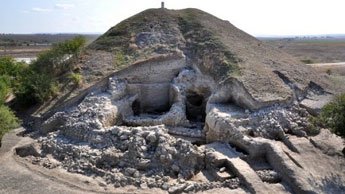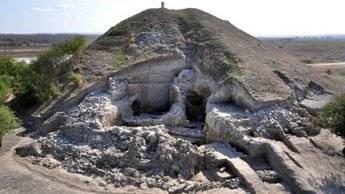Europe’s oldest prehistoric town found in Bulgaria
Source: france24.com
Archaeologists in Bulgaria have discovered the oldest prehistoric town ever found in Europe, dating back to the fifth millennium BC. An ancient salt production site was also found at the Provadia-Solnitsata settlement located in the country’s east.  Archaeologists in eastern Bulgaria say they have unearthed the oldest prehistoric town ever found in Europe, along with an ancient salt production site that gives a strong clue about why massive riches were discovered in the region.
Archaeologists in eastern Bulgaria say they have unearthed the oldest prehistoric town ever found in Europe, along with an ancient salt production site that gives a strong clue about why massive riches were discovered in the region.Excavations at the site near the modern-day town of Provadia have so far uncovered the remains of a settlement of two-storey houses, a series of pits used for rituals as well as parts of a gate, bastion structures and three later fortification walls - all carbon dated between the middle and late Chalcolithic age from 4,700 to 4,200 BC.
"We are not talking about a town like the Greek city-states, ancient Rome or medieval settlements, but about what archaeologists agree constituted a town in the fifth millennium BC," said Vasil Nikolov, a researcher with Bulgaria’s National Institute of Archeology, after announcing the findings earlier this month.
Nikolov and his team have worked since 2005 to excavate the Provadia-Solnitsata settlement, located near the Black Sea resort of Varna.
A small necropolis, or burial ground, was also found this year, but has yet to be studied more extensively and could keep archaeologists busy for generations.
Archeologist Krum Bachvarov from the National Institute of Archeology qualified this latest find as "extremely interesting" due to the peculiar burial positions and objects found in the graves, which differed from other neolithic graves found in Bulgaria.
"The huge walls around the settlement, which were built very tall and with stone blocks...are also something unseen in excavations of prehistoric sites in southeast Europe so far," Bachvarov added.
Well fortified, a religious centre and most importantly, a major production centre for a specialised commodity that was traded far and wide, the settlement of about 350 people met all the conditions to be considered the oldest known "prehistoric town" in Europe, the team says.
"At a time when people did not know the wheel and cart these people hauled huge rocks and built massive walls. Why? What did they hide behind them?" Nikolov asked.
The answer: "Salt."
As precious as gold
The area is home to huge rock-salt deposits, some of the largest in southeast Europe and the only ones to be exploited as early as the sixth millennium BC, Nikolov said.
This is what made Provadia-Solnitsata what it was.
Nowadays, salt is still mined there but 7,500 years ago it had a completely different significance.
"Salt was an extremely valued commodity in ancient times, as it was both necessary for people’s lives and was used as a method of trade and currency starting from the sixth millennium BC up to 600 BC," the researcher explained.
[...]
Read the full article at: france24.com






















